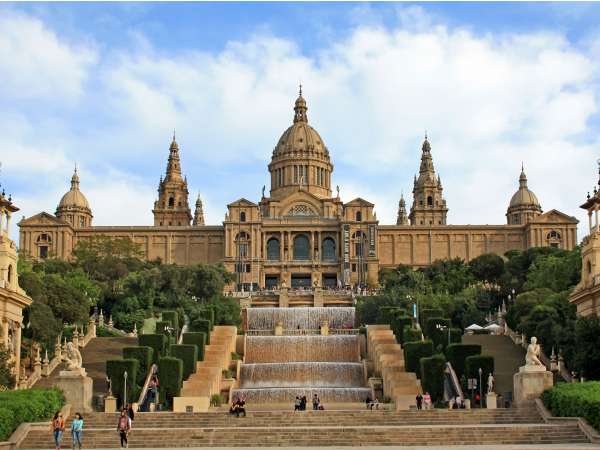
The National Palace of Montjuïc in Barcelona, also known as Palau Nacional, is not only a remarkable building on the hill of Montjuïc, but also a cultural center that attracts thousands of visitors every year. Built between 1926 and 1929 for the 1929 International Exposition, the Palau Nacional has been the headquarters of the National Art Museum of Catalonia (MNAC) since 1934. The museum has one of the best collections of Romanesque art in the world, and its location on the hill of Montjuïc offers visitors stunning views of the city. In this article, we will explore the history, location, opening hours, admission prices and other interesting facts about the National Palace of Montjuïc and its surroundings.
History
Barcelona’s majestic Montjuïc National Palace has a proud history dating back to the 1929 International Exposition. Created by Eugenio Cendoya and Enric Catà, under the direction of Pere Domènech i Roura, the building was conceived to be the nerve center of the exhibition. Its impressive Renaissance architecture, built between 1926 and 1929, has become an emblem of the city’s cultural heritage for almost a century, and since 1934 it has housed the National Art Museum of Catalonia (MNAC).
The Palau Nacional has been an integral part of Barcelona’s social and cultural life since its beginnings, having hosted many events, exhibitions and concerts. Originally built for the 1929 International Exposition, its great success gave the city a reputation as a cultural center. Today, this building remains a symbol of the city’s vibrant cultural history and is a must-see destination for any art and architecture aficionado. His narrative speaks to the city’s resilience and creativity and is a testament to its enduring cultural legacy.
Location
Perched atop the hill of Montjuïc is the majestic National Palace of Montjuïc, an icon of Barcelona built between 1926 and 1929 by architects Eugenio Cendoya and Enric Catà. From this vantage point, visitors can enjoy breathtaking panoramic views of the city, as well as other attractions such as Montjuïc Castle and the Magic Fountain.
Getting to the palace is very easy; there are several bus lines and a funicular that connects Montjuïc with the city center. You can also take a cable car from the port of Barcelona for a breathtaking ride overlooking the Mediterranean Sea and the Barcelona skyline. Once there, visitors can explore the National Art Museum of Catalonia (MNAC) and its impressive collection of Romanesque art or stroll through the tranquil gardens at their leisure.
- The Palace was built for the Barcelona International Exposition, between 1926 and 1929.
- It was designed by architects Eugenio Cendoya and Enric Catà, and supervised by Domènech i Roura, son of the well-known modernist architect Lluís Domènec i Montaner.
- It has a classicist and renaissance style.
- It was inaugurated by King Alfonso XIII and his wife María Eugenia.
- Since 1934, the Montjuïc Palace has housed the National Art Museum of Catalonia (MNAC).
- The building that houses the Palace of Montjuïc, which has about 32,000 square meters, with a rectangular floor plan with two lateral bodies and a square rear one with a large elliptical dome in the central part.
- 16 stone columns support its spectacular central dome.
- The interior decoration of the Palace, designed by several artists, is in the noucentista style. Enric Casanovas, Josep Dunyach, Josep Llimona, Josep de Tagores, Josep Obiols, Francesc d’Assís Galí, were just some of these artists.
- Its exterior architecture, terraces and rooftop terrace stand out. In addition, these areas have been enabled to receive visits from the public, so you can enjoy unique views from there.
- The National Art Museum of Catalonia (MNAC), which is located inside the building, is one of its main attractions and a reason for continuous visits.
If you want to visit the Montjuïc National Palace, this information will be useful:
Hours: Tuesday to Saturday from 10:00 to 19:00 h. Sundays and holidays from 10:00 to 14:30 h.
Price: 8,50 € (this price could vary).
In conclusion, Barcelona’s Montjuïc National Palace is a must-see attraction for art and architecture enthusiasts alike. Its rich history as the main venue for the 1929 International Exposition, together with its impressive location on the hill of Montjuïc, make it a true jewel of the city. The National Art Museum of Catalonia (MNAC), inside the Palau Nacional, houses one of the best collections of Romanesque art in the world, and the Castell de Montjuïc offers breathtaking views of Barcelona. Don’t miss the opportunity to explore the collection of academic classicism and immerse yourself in the beauty and culture of this historic monument.
